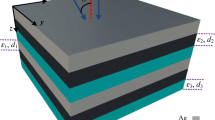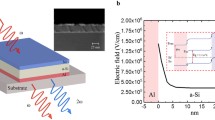Abstract
An optical metamaterial is a composite in which subwavelength features, rather than the constituent materials, control the macroscopic electromagnetic properties of the material. Recently, properly designed metamaterials have garnered much interest because of their unusual interaction with electromagnetic waves1,2,3. Whereas nature seems to have limits on the type of materials that exist, newly invented metamaterials are not bound by such constraints. These newly accessible electromagnetic properties make these materials an excellent platform for demonstrating unusual optical phenomena and unique applications such as subwavelength imaging and planar lens design. ‘Negative-index materials’, as first proposed, required the permittivity, ɛ, and permeability, μ, to be simultaneously less than zero, but such materials face limitations. Here, we demonstrate a comparatively low-loss, three-dimensional, all-semiconductor metamaterial that exhibits negative refraction for all incidence angles in the long-wave infrared region and requires only an anisotropic dielectric function with a single resonance. Using reflection and transmission measurements and a comprehensive model of the material, we demonstrate that our material exhibits negative refraction. This is furthermore confirmed through a straightforward beam optics experiment. This work will influence future metamaterial designs and their incorporation into optical semiconductor devices.



Similar content being viewed by others
References
Veselago, V. G. Electrodynamics of substances with simultaneously negative values of sigma and mu. Sov. Phys. Usp. 10, 509 (1968).
Smith, D. R., Padilla, W. J., Vier, D. C., Nemat-Nasser, S. C. & Schultz, S. Composite medium with simultaneously negative permeability and permittivity. Phys. Rev. Lett. 84, 4184–4187 (2000).
Shelby, R. A., Smith, D. R. & Schultz, S. Experimental verification of a negative index of refraction. Science 292, 77–79 (2001).
Moser, H. O., Casse, B. D. F., Wilhelmi, O. & Saw, B. T. Terahertz response of a microfabricated rod-split-ring-resonator electromagnetic metamaterial. Phys. Rev. Lett. 94, 063901 (2005).
Koschny, T., Kafesaki, M., Economou, E. N. & Soukoulis, C. M. Effective medium theory of left-handed materials. Phys. Rev. Lett. 93, 107402 (2004).
Shalaev, V. M. et al. Negative index of refraction in optical metamaterials. Opt. Lett. 30, 3356–3358 (2005).
Zhang, S. et al. Experimental demonstration of near-infrared negative-index metamaterials. Phys. Rev. Lett. 95, 137404 (2005).
Zhang, S. et al. Demonstration of metal-dielectric negative-index metamaterials with improved performance at optical frequencies. J. Opt. Soc. Am. B 23, 434–438 (2006).
Podolskiy, V. A. & Narimanov, E. E. Strongly anisotropic waveguide as a nonmagnetic left-handed system. Phys. Rev. B 71, 201101 (2005).
Pendry, J. B. A chiral route to negative refraction. Science 306, 1353–1355 (2004).
Alu, A. & Engheta, N. Optical nanotransmission lines: Synthesis of planar left-handed metamaterials in the infrared and visible regimes. J. Opt. Soc. Am. B 23, 571–583 (2006).
Ivanov, O. V. & Sementsov, D. I. Light propagation in stratified chiral media. The 4×4 matrix method. Crystallogr. Rep. 45, 487–492 (2000).
Grzegorczyk, T. M., Nikku, M., Chen, X. D., Wu, B. I. & Kong, J. A. Refraction laws for anisotropic media and their application to left-handed metamaterials. IEEE Trans. Microw. Theory Tech. 53, 1443–1450 (2005).
Shalaev, V. M. Optical negative-index metamaterials. Nature Photon. 1, 41–48 (2007).
Berreman, D. W. Optics in stratified and anisotropic media: 4×4-matrix formulation. J. Opt. Soc. Am. 62, 502–510 (1972).
Acknowledgements
The authors would like to thank PRISM, PCCM MRSEC, MIRTHE (NSF-ERC) and ARO-MURI for support of this project. In addition, we would like to thank Z. Jacob for useful discussions.
Author information
Authors and Affiliations
Corresponding author
Supplementary information
Supplementary Information
Supplementary discussions and figures 1-6 (PDF 347 kb)
Rights and permissions
About this article
Cite this article
Hoffman, A., Alekseyev, L., Howard, S. et al. Negative refraction in semiconductor metamaterials. Nature Mater 6, 946–950 (2007). https://doi.org/10.1038/nmat2033
Received:
Accepted:
Published:
Issue Date:
DOI: https://doi.org/10.1038/nmat2033
- Springer Nature Limited
This article is cited by
-
Thermally tunable Dyakonov surface waves in semiconductor nanowire metamaterials
Scientific Reports (2023)
-
Highly directional and carrier density-independent plasmons in quasi-one-dimensional electron gas systems
Communications Physics (2023)
-
Broadband continuous supersymmetric transformation: a new paradigm for transformation optics
eLight (2022)
-
Hyperbolic metamaterials: fusing artificial structures to natural 2D materials
eLight (2022)
-
All-angle reflectionless negative refraction with ideal photonic Weyl metamaterials
Light: Science & Applications (2022)





